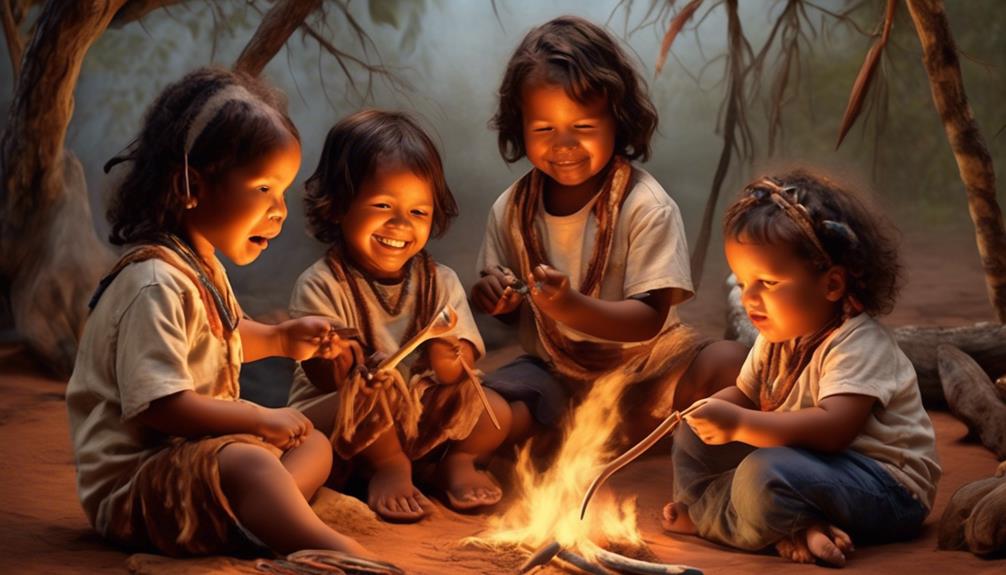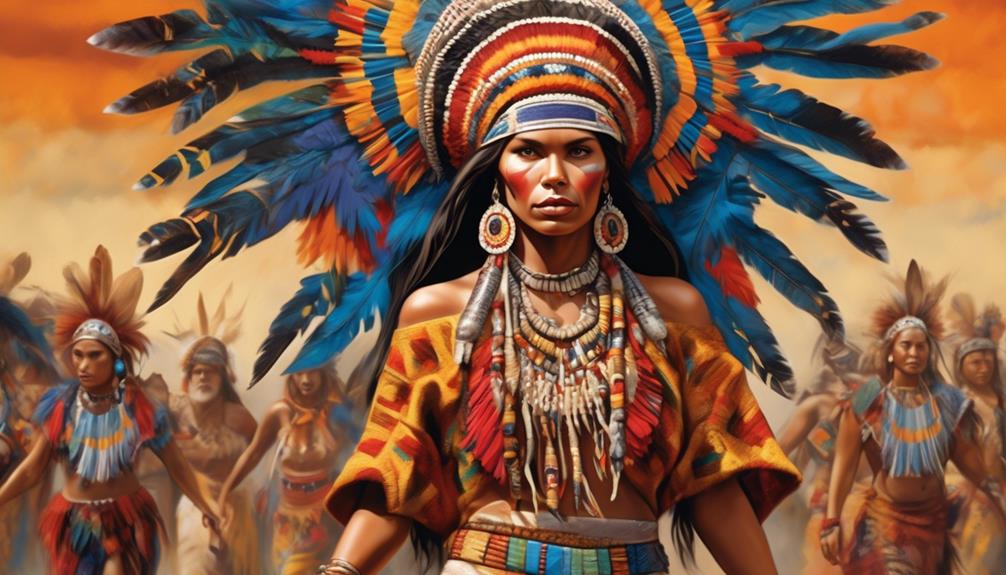Step into a world brimming with deep cultural traditions and heritage by exploring activities tailored for young children that honor Aboriginal culture. These activities provide an opportunity for your little ones to form a connection with the land and its stories, creating a unique and meaningful learning experience.
From storytelling with Dreamtime tales to sensory play with bush tucker exploration, there is a wealth of activities that will captivate and educate your toddlers. These activities offer an opportunity for your children to develop a deep appreciation for the wisdom and traditions of Australia's First Nations peoples, while also nurturing their creativity and curiosity.
Key Takeaways
- Engaging toddlers in Dreamtime storytelling promotes language development and imaginative play.
- Traditional Aboriginal music and dance can help toddlers develop an appreciation for diversity and rhythm.
- Introducing toddlers to Indigenous art projects, such as dot painting, fosters cultural understanding and creativity.
- Sensory exploration of Bush Tucker enhances curiosity, appreciation for the natural world, and connection to Aboriginal communities.
Storytelling With Dreamtime Tales
Engage your toddlers in the rich tradition of Dreamtime storytelling through interactive and imaginative activities. Cultivating cultural understanding from a young age is crucial, and sharing Dreamtime tales is a wonderful way to do so. Encourage imaginative play by acting out the stories with your little ones. Use props and costumes to bring the tales to life, allowing them to immerse themselves in the narratives. This not only fosters a deeper connection to Aboriginal culture but also enhances their creativity and communication skills.
Another engaging activity is creating Dreamtime story stones. Gather smooth stones and paint them with symbols representing various Dreamtime stories. Then, use these stones to retell the tales, allowing your toddlers to arrange them in their own sequence and narrate the stories in their own words. This interactive exercise not only promotes cultural understanding but also encourages language development and storytelling abilities.
Traditional Aboriginal Music and Dance

Discover the vibrant world of Traditional Aboriginal music and dance, inviting toddlers to explore and participate in the rich cultural expressions of rhythm and movement. Traditional Aboriginal music and dance are integral parts of Indigenous Australian cultural traditions. This aspect of Aboriginal culture provides an opportunity for toddlers to engage in sensory experiences, learn about traditional stories and cultural practices, and develop an appreciation for diversity.
| Music | Dance |
|---|---|
| Didgeridoo | Corroboree |
| Clapsticks | Ground designs |
| Songlines | Body painting |
The music component often includes the powerful sound of the didgeridoo, rhythmic use of clapsticks, and storytelling through songlines. Likewise, the dance component incorporates the energetic and symbolic movements of the corroboree, as well as the visual representation of cultural stories through ground designs and body painting. Through engaging in traditional music and dance, toddlers are encouraged to embrace cultural diversity, develop a sense of rhythm, and express themselves through movement. By incorporating these traditional elements into play-based activities, toddlers can gain a deeper understanding of Indigenous Australian culture and foster a sense of inclusivity and respect for cultural traditions.
Indigenous Art Projects for Toddlers
As you introduce toddlers to the vibrant world of Traditional Aboriginal music and dance, you can continue to foster their cultural understanding and creativity through engaging Indigenous art projects. Indigenous art offers a beautiful way to connect toddlers with Aboriginal culture.
Here are some engaging art projects to explore with toddlers:
- Dot Painting: Introduce toddlers to the mesmerizing art of dot painting, a technique used by Aboriginal artists to depict cultural symbols and stories. Provide them with non-toxic paints and large paper or canvas to create their own dot paintings, encouraging them to use vibrant colors and explore different patterns.
- Handprint Stencils: Embrace the storytelling tradition of Indigenous culture by helping toddlers create handprint stencils. Encourage them to decorate their stencils with symbols and motifs significant to Aboriginal heritage. This activity not only fosters creativity but also introduces toddlers to the importance of storytelling in Aboriginal culture.
- Nature Collages: Encourage toddlers to collect natural materials like leaves, feathers, and twigs to create nature collages. This activity connects them to the land and its significance in Indigenous art and culture.
- Dreamtime Storytelling: Engage toddlers in storytelling sessions about Dreamtime stories while they create art inspired by these tales. This will help them understand the cultural significance of art in preserving and sharing traditional stories.
Sensory Play With Bush Tucker Exploration

Explore the rich sensory experience of Bush Tucker with toddlers through hands-on play and discovery. Bush tucker tasting can be a wonderful way for toddlers to engage their senses and learn about the native plants and fruits that have sustained Aboriginal communities for generations. When organizing bush tucker tasting activities, ensure that the items are safe for consumption and appropriate for the toddlers' age. Encourage children to touch, smell, and taste the different bush tucker items, fostering a sense of curiosity and appreciation for the natural world.
Sensory nature walks are another fantastic way to introduce toddlers to bush tucker. Take them on a gentle stroll through a natural setting and encourage them to use all of their senses to explore the environment. Encourage them to feel the textures of leaves and bark, listen to the sounds of birds and insects, and observe the colors and shapes of the plants around them.
Point out different bush tucker plants and explain their significance, creating a meaningful and educational experience for the toddlers.
Nature-Based Outdoor Activities for Toddlers
Engage toddlers in the wonders of the natural world through hands-on nature-based activities that encourage curiosity and exploration. Outdoor adventures provide an excellent opportunity for toddlers to connect with nature and develop a sense of wonder and appreciation for the environment.
Here are some nature-based outdoor activities that will captivate toddlers and foster a love for the outdoors:
- Nature Scavenger Hunt: Create a list of items found in nature such as pinecones, leaves, rocks, and flowers. Encourage toddlers to find and collect these items, promoting observation and discovery.
- Sensory Nature Walk: Take toddlers on a sensory nature walk, encouraging them to feel the different textures of leaves, bark, and flowers. This activity stimulates their senses and enhances their connection to the natural world.
- Bird Watching: Introduce toddlers to the world of birds by observing and listening to their sounds. Use simple bird identification cards to help them recognize and appreciate different bird species.
- Outdoor Art: Provide toddlers with non-toxic paint and paper to create nature-inspired artwork using leaves, twigs, and flowers. This activity allows them to express creativity while exploring nature.
These nature-based activities will spark a sense of wonder and curiosity in toddlers, fostering a lifelong love for exploring nature.
Frequently Asked Questions
How Can I Incorporate Aboriginal Activities Into My Toddler's Daily Routine at Home?
Incorporate traditional crafts, storytelling, and outdoor play into your toddler's routine. Consider cultural aspects and language learning.
Engage respectfully and use educational resources to make the activities inclusive and educational.
Are There Any Specific Cultural Considerations to Keep in Mind When Engaging in Aboriginal Activities With Toddlers?
When engaging in cultural activities with toddlers, it's important to keep cultural sensitivity in mind. This involves being respectful and mindful of the traditions and practices of the culture you're immersing in.
It's essential to provide a culturally immersive experience that honors and celebrates the traditions, while also being inclusive and play-based for toddlers. This approach fosters a deeper understanding and appreciation of the culture in a developmentally appropriate way.
What Are Some Age-Appropriate Ways to Teach My Toddler About the Significance of Aboriginal Traditions and Customs?
To teach your toddler about the significance of Aboriginal traditions and customs, engage in interactive storytelling. Use age-appropriate books and props to bring stories to life.
Take them on outdoor explorations to connect with nature and learn about traditional practices.
Encourage hands-on activities like making crafts or cooking traditional foods.
Be mindful of cultural sensitivity and involve them in play-based, inclusive experiences to foster understanding and respect for Aboriginal cultures.
Are There Any Recommended Resources or Materials for Creating an Aboriginal-Themed Learning Environment for Toddlers?
Looking for recommended materials to create an authentic aboriginal-themed environment for toddlers?
Incorporate Indigenous art to foster cultural appreciation and storytelling activities to engage their imagination.
Consider using traditional tools like dream catchers and indigenous animal figurines to make the environment immersive.
Have you thought about using natural materials like feathers and stones to create sensory experiences that connect toddlers with aboriginal traditions?
How Can I Respectfully Introduce My Toddler to Aboriginal Languages and Communication Styles?
To respectfully introduce your toddler to aboriginal languages and communication styles, start by learning together. Incorporate simple words or phrases into daily activities and play. Use storytelling, songs, and games to explore the sounds and rhythms of the language.
Engage with indigenous communities for authentic experiences. Embrace cultural diversity and emphasize respect. Encourage open-mindedness and curiosity in your child's exploration of different communication styles.
Conclusion
In conclusion, engage your toddlers in the rich culture and traditions of Aboriginal communities through:
- Storytelling
- Music
- Art
- Sensory play
- Outdoor activities
By immersing them in these activities, you're fostering a deep connection to the land, the people, and the stories that have been passed down for generations.
Embrace the beauty and wonder of Aboriginal culture with your little ones, creating cherished memories and a foundation of respect and understanding for the Indigenous community.









